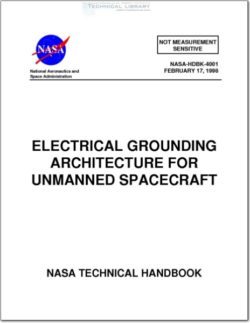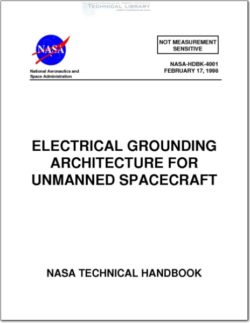NASA-HDBK-4001

- Version
- 201 Downloads
- 391.24 KB File Size
- 1 File Count
- May 14, 2016 Create Date
- May 14, 2016 Last Updated
Electrical Grounding Architecture for Unmanned Spacecraft

ELECTRICAL GROUNDING ARCHITECTURE
FOR UNMANNED SPACECRAFT
1. SCOPE
1.1 Scope. This handbook describes spacecraft grounding architecture options at the
system level. Implementation of good electrical grounding architecture is an important part of
overall mission success for spacecraft. The primary objective of proper grounding architecture
is to aid in the minimization of electromagnetic interference (EMI) and unwanted interaction
between various spacecraft electronic components and/or subsystems. Success results in
electromagnetic compatibility (EMC). This handbook emphasizes that spacecraft grounding
architecture is a system design issue, and all hardware elements must comply with the
architecture established by the overall system design. A further major emphasis is that
grounding architecture must be established during the early conceptual design stages (before
subsystem hardware decisions are made). The preliminary design review (PDR) time is too
late.
1.2 Purpose. The purpose of this handbook is to provide a ready reference for
spacecraft systems designers and others who need information about system grounding
architecture design and rationale. The primary goal of this handbook is to show design
choices that apply to a grounding system for a given size and mission of spacecraft and to
provide a basis for understanding those choices and tradeoffs.
1.3 Applicability. This handbook recommends engineering practices for NASA
programs and projects. It may be cited in contracts and program documents as a reference for
guidance. Determining the suitability of this handbook and its provisions is the responsibility of
program/project management and the performing organization. Individual provisions of this
handbook may be tailored (i.e., modified or deleted) to meet specific program/project needs
and constraints. The handbook is specifically intended for application to NASA unmanned
spacecraft. Other spacecraft development efforts can benefit to the degree that they are
similar in their mission.
1.4 Constraints. This handbook does not cover personnel safety (such as the National
Electrical Code) or regulatory compliance (such as Federal Communications Commission
regulations). No practice recommended in this Handbook is hazardous.
Grounding of structure (bonding of non-electrical elements) is not the subject of this handbook.
There is a short bonding section (ref. 3.4) that refers to another appropriate document.
| File | Action |
|---|---|
| NASA-HDBK-4001 Electrical Grounding Architecture for Unmanned Spacecraft.pdf | Download |

Comment On This Post